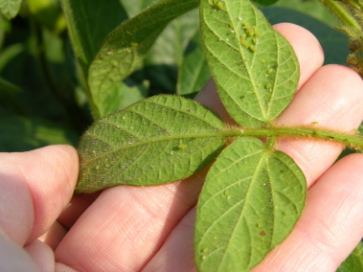There is a long way to go yet before we reach crop maturity and a few insects are thriving right now in late planted soybeans and dry beans.
Bean leaf beetles are a risk for both soybeans and dry beans. Reports are starting to come in of some activity at various locations. This is the first generation of adults; what comes from the overwintering generation that mated and laid eggs in the soil in late spring. They feed on leaves but this injury is less of a concern after R3. The real concern is when they start to feed on pods or clip pods off the plants, especially in IP, Food-Grade, Seed Soybeans and Dry Beans.
Defoliation is always overestimated and edge rows and top leaves will always have more feeding than the rest of the field so make sure to step at least 5 meters into the field before sampling leaves. From 10 random plants nearby, pluck tri-foliates from the middle of the canopy and discard the worst and best of the three leaflets before estimating how much defoliation is on the remaining leaflet. My trick to determine how much defoliation is done is to visually push all of the holes to one end of the leaflet to determine how much is gone versus what is remaining. Do this for 5 areas of the field. Also look for any signs of pod feeding or clipped pods on the ground as you are walking the field.
Defoliation threshold: If the average defoliation taking place is 15% during R1 to R4 stage, than a spray is warranted. If the crop is in R5 or R6 stage, a spray is only warranted if defoliation is 25% or higher.
Pod feeding threshold for IP, Food Grade and Seed Soybeans: If 10% of the pods on the plants have feeding injury AND the beetles are still active in the field, a spray is warranted. If pods are being clipped and found on the ground, an application is warranted if beetles are still active in the field. For Dry Beans: With higher value and stringent quality standards in dry edible beans, if 5%–8% of the pods inspected have feeding scars, control may be necessary. If pods are being clipped and found on the ground, an application is also warranted. Ensure that adults are still presently active in the field before a spray is applied.

Soybean aphids are also starting to appear in some soybean fields. Their optimal temperature range is around 25 degrees C which is where are forecast seems to be hovering at to lately. One positive note is that there are lots of natural enemies out there in many of the crops this year. So they may be able to keep the aphids in check but the crop canopy is not as lush as usual so scouting often is important. Remember that the economic injury level for soybean aphids is 660 aphids per plant. We set the action threshold at 250 aphids per plant but there is some wiggle room above that number. It gives you a seven day window to get a sprayer if in needed before they reach that economic injury level. Experience shows that natural enemies can cause the aphid population to fluctuate and in many cases, not reach the economic injury level. Especially when temperatures are not too extreme for the natural enemies. Scout fields at least twice before making a spray decision. If the aphid population continues to steadily increase above 250 aphids per plant and has not been fluctuating thanks to the natural enemies, then a spray may be warranted. In lush canopies, you can afford to wait until the average population is closer to 500 per plant. If in doubt, use the free Aphid Advisor app to help you decide when to spray. It guides you through the decision making process, taking into consideration the ratio of natural enemies to aphids and calculates whether there are enough to keep them from reaching the economic injury level. The Aphid Advisor app is available at:
http://www.aphidapp.com/
There are two other pests that may show up soon. Corn earworm could start to lay eggs in dry beans given the abundant populations that we are seeing in corn and other host crops. While scouting for WBC, check for holes in pods. Open up any pods and see if a larva is inside. If it is, it is likely corn earworm or European corn borer since WBC larvae only feed at night.
Spider mites are the next threat. If we don’t see more frequent rain events soon, spider mites could start showing up in soybeans, dry beans and even corn. Look for signs of stippling that makes the crop look sandblasted. Turn leaves over to look for tiny dots moving on the leaves. More info on spider mites can be found in this previous article:
http://fieldcropnews.com/2016/08/two-spotted-spider-mites-in-edible-beans-and-soybeans/